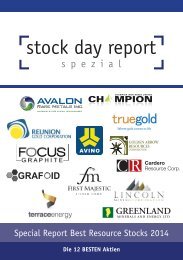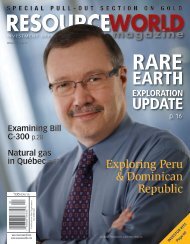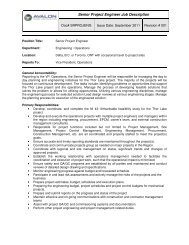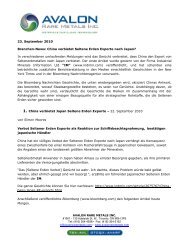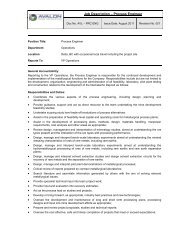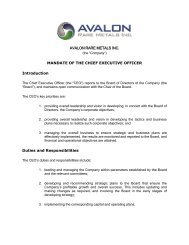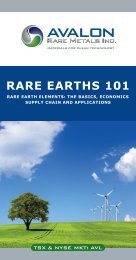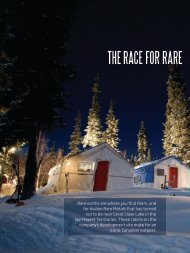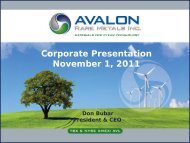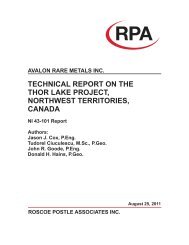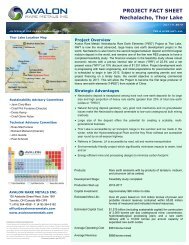technical report on the nechalacho deposit, thor lake project ...
technical report on the nechalacho deposit, thor lake project ...
technical report on the nechalacho deposit, thor lake project ...
You also want an ePaper? Increase the reach of your titles
YUMPU automatically turns print PDFs into web optimized ePapers that Google loves.
In a typical test, for example CCr-27, c<strong>on</strong>centrate was treated with sodium hydroxide at 600°C<br />
for three hours, cooled, <strong>the</strong>n water washed to remove excess sodium hydroxide and <strong>the</strong><br />
phosphates and silicates formed in <strong>the</strong> cracking process. The solids were <strong>the</strong>n leached with<br />
hydrochloric acid and yielded 96% zirc<strong>on</strong>ium extracti<strong>on</strong> and more than 96% solubilizati<strong>on</strong> of <strong>the</strong><br />
rare earths.<br />
O<strong>the</strong>r approaches to <strong>the</strong> caustic cracking process have been investigated including cracking<br />
tests using sodium carb<strong>on</strong>ate, cracking in an autoclave using str<strong>on</strong>g caustic soluti<strong>on</strong>, cracking in<br />
<strong>the</strong> presence of reductants, and low temperature attriti<strong>on</strong> milling with sodium hydroxide. Some<br />
of <strong>the</strong>se tests provided encouraging results and fur<strong>the</strong>r tests have been planned.<br />
Ano<strong>the</strong>r approach to cracking refractory minerals is acid baking in which <strong>the</strong> feed material is<br />
mixed with c<strong>on</strong>centrated sulphuric acid and held at a temperature of 200°C or more for a few<br />
hours. This method is widely used in China for decomposing <strong>the</strong> rare earth c<strong>on</strong>centrates from<br />
Bayan Obo and elsewhere.<br />
SGS has investigated <strong>the</strong> use of acid baking for <strong>the</strong> Thor Lake c<strong>on</strong>centrate and it has been<br />
seen to solubilize about 80% of <strong>the</strong> light rare earths and 50% of <strong>the</strong> heavy rare earths. Zirc<strong>on</strong><br />
extracti<strong>on</strong> is minimal, less than 4%, even under extreme acid bake c<strong>on</strong>diti<strong>on</strong>s clearly indicating<br />
<strong>the</strong> refractory nature of zirc<strong>on</strong>.<br />
SGS Mineral Services has also investigated <strong>the</strong> use amm<strong>on</strong>ium sulphate or amm<strong>on</strong>ium chloride<br />
as acid baking reagents. Some elements were extracted but no fur<strong>the</strong>r work is planned.<br />
A combinati<strong>on</strong> of acid baking and caustic cracking has also been investigated and shown to<br />
offer high recoveries and preferred reagent c<strong>on</strong>sumpti<strong>on</strong> levels and operating costs. As<br />
<str<strong>on</strong>g>report</str<strong>on</strong>g>ed in <strong>the</strong> previous Technical Report, extracti<strong>on</strong>s under favourable c<strong>on</strong>diti<strong>on</strong>s are typified<br />
by <strong>the</strong> results of AB-19 in which overall zirc<strong>on</strong>ium recovery was 99%, overall light rare earth<br />
(lanthanum, cerium and neodymium) extracti<strong>on</strong> was 98%, and extracti<strong>on</strong> of <strong>the</strong> heavy rare<br />
earths and yttrium was 99%. Niobium extracti<strong>on</strong> was 83%<br />
Although it is clear that a very effective process for solubilizing <strong>the</strong> valuable elements in <strong>the</strong><br />
Thor Lake c<strong>on</strong>centrate had been identified, testwork is c<strong>on</strong>tinuing at SGS Mineral Services to<br />
fur<strong>the</strong>r define <strong>the</strong> process parameters and optimize <strong>the</strong> flowsheet for <strong>the</strong> initial solubilizati<strong>on</strong><br />
step.<br />
Extracting valuable elements from <strong>the</strong> refractory minerals of <strong>the</strong> c<strong>on</strong>centrate is a key part of <strong>the</strong><br />
hydrometallurgical process. Once <strong>the</strong> elements of interest are in soluti<strong>on</strong>, it is necessary to<br />
separately recover <strong>the</strong> zirc<strong>on</strong>ium, rare earths, yttrium, niobium and tantalum and this has been<br />
investigated in <strong>the</strong> laboratory. The flowsheet that was selected for <strong>the</strong> pre-feasibility study<br />
Technical Report 43-101 – March 13, 2011 Page 16-3<br />
Prepared by Aval<strong>on</strong> Rare Metals Inc.



